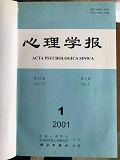|
|
THEORY OF DESIRES AND EMOTIONS IN PRE-QIN PERIOD
Guo Yongyu (Department of Psychology, Huazhong Normal University, Wuhan 430079)
2001, 33 (1):
82-87.
This paper explored the theories about desires and emotions in pre-Qin perio d which is a phase of ancient Chinese psychological history. There were four asp ects about the subject: desires, emotions, theirrelationship, the theorists’ at titudes to desires and emotions of human beings. The paper involved the theorist s such as Confucius, Mencius, Xun Zi, Lao Zi, Zhuang Zi, Mo Zi, Han Fei Zi, and so on. Also the paper discussed the theorists’ contribution to modern psycholog y and the value to modern human being. The scholars of the pre-Qin period shared nearly the same opinion of the nat ure and the varieties of desires. They treated desires from the point of human n ature and classified it into several basic categories. Those desires for food an d clothes were regarded as primary ones. In the discussions about emotions by th e pre-Qin scholars, several points should be paid special attention to: emotions and desires are not separable; man has several basic emotions such as pleasure, anger, sorrow and enjoyment;emotions find outlets in expressions, facial or voc al; it was nice for people to be sincere and to treat others with universal love , pities and sympathy. No systematic theories about the relationship between des ires and emotions can be found, but we may conclude that the emphasis of the pre decessors’ argument was “which was the basis on which the other was produced”. Some scholars such as Xun Zi insisted that inherent nature was the most essential, while the majority took the opposite stand. In this argument, Mencius had a surprisingly radical viewpoint of filial piety, which is in fact a reflection of the subconscious wish of being forever in one’s childhood. He t hought that even though all the desires for music, color, wealth and honor were satisfied, it was still impossible to relieve one’s anxiety, which,according to him, could only be relieved by filial piety to one’s parents. Referring to the treatment of desires and emotions, the pre-Qin scholars mostly agreed to check them. Generally speaking, the viewpoints possessed by Confucius and Xun Zi are r ational and practical, whereas the spiritual freedom by Zhuang Zi, the sentiment s of a savior by Mo Zi, and the heroic personality by Mencius are beyond the rea ch of the common. Lao Zi and Han Fei Zi stood for non-desire and check of the ma ss’ desires, which can be viewed as a conservative thought of politics in the t ime of extremely low productivity.
Related Articles |
Metrics
|




